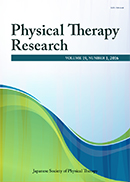Virtual issue
Volume 22, Issue 1
Displaying 1-7 of 7 articles from this issue
- |<
- <
- 1
- >
- >|
Scientific Research Article
-
2019 Volume 22 Issue 1 Pages 1-8
Published: June 20, 2019
Released on J-STAGE: June 20, 2019
Advance online publication: March 11, 2019Download PDF (135K) -
2019 Volume 22 Issue 1 Pages 9-16
Published: June 20, 2019
Released on J-STAGE: June 20, 2019
Advance online publication: April 20, 2019Download PDF (104K) -
2019 Volume 22 Issue 1 Pages 17-25
Published: June 20, 2019
Released on J-STAGE: June 20, 2019
Advance online publication: May 20, 2019Download PDF (116K)
Brief Report
-
2019 Volume 22 Issue 1 Pages 26-30
Published: June 20, 2019
Released on J-STAGE: June 20, 2019
Advance online publication: March 11, 2019Download PDF (71K)
Review
-
2019 Volume 22 Issue 1 Pages 31-37
Published: June 20, 2019
Released on J-STAGE: June 20, 2019
Download PDF (165K) -
2019 Volume 22 Issue 1 Pages 38-43
Published: June 20, 2019
Released on J-STAGE: June 20, 2019
Download PDF (71K)
Editorial Board
-
2019 Volume 22 Issue 1 Pages e1
Published: June 20, 2019
Released on J-STAGE: June 20, 2019
Download PDF (29K)
- |<
- <
- 1
- >
- >|
